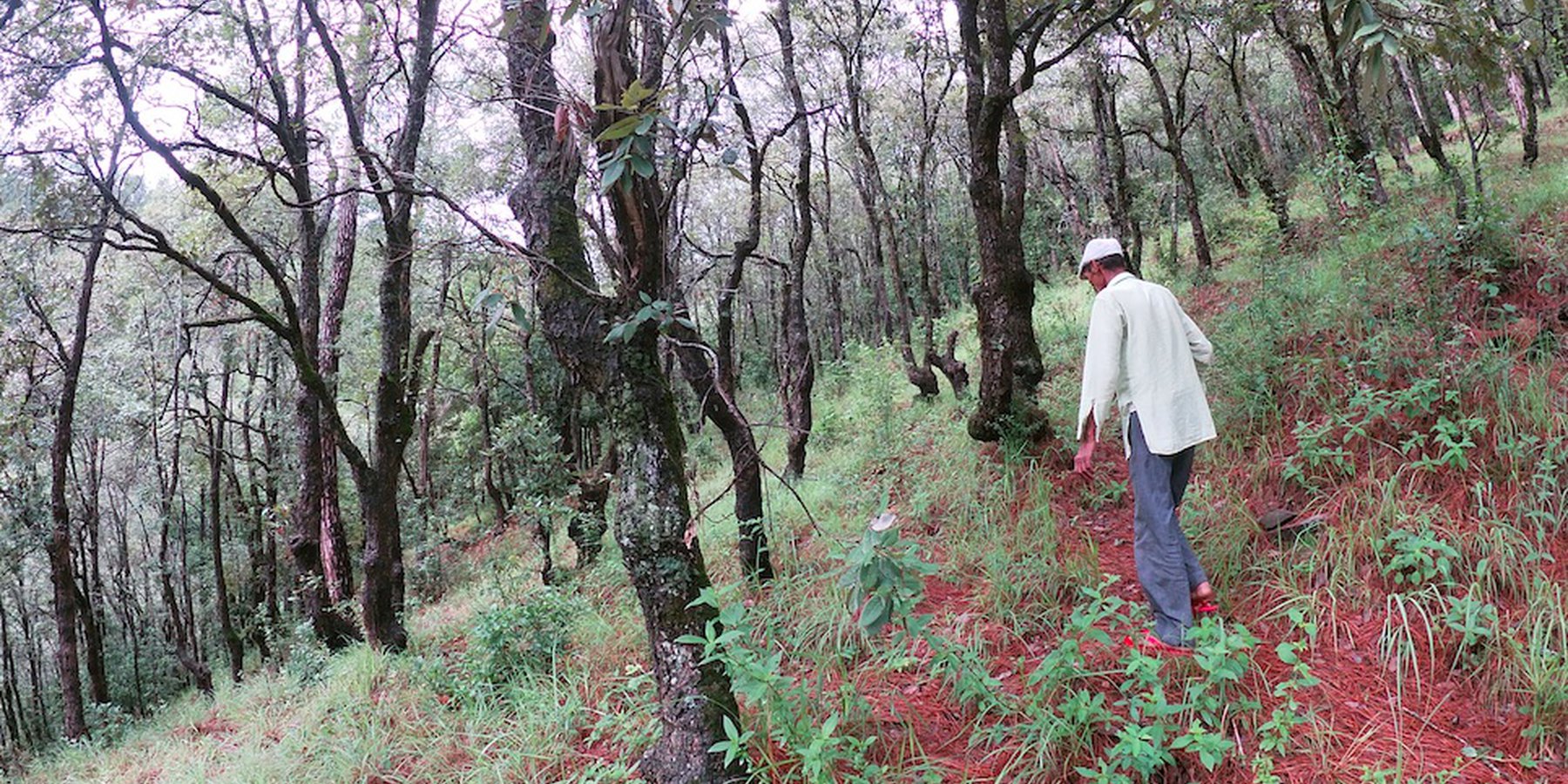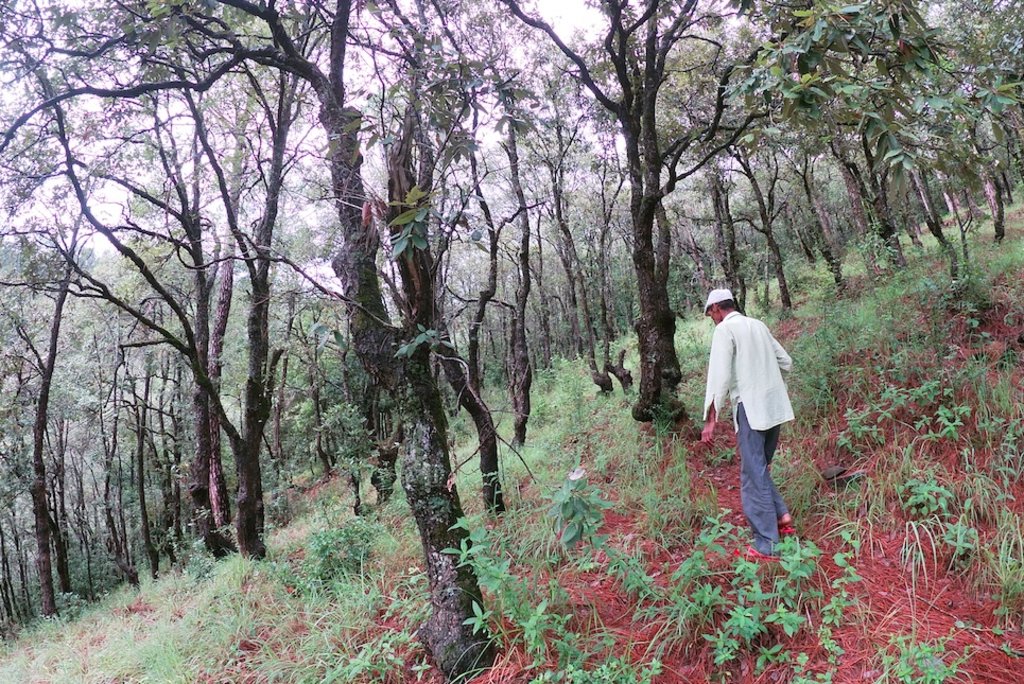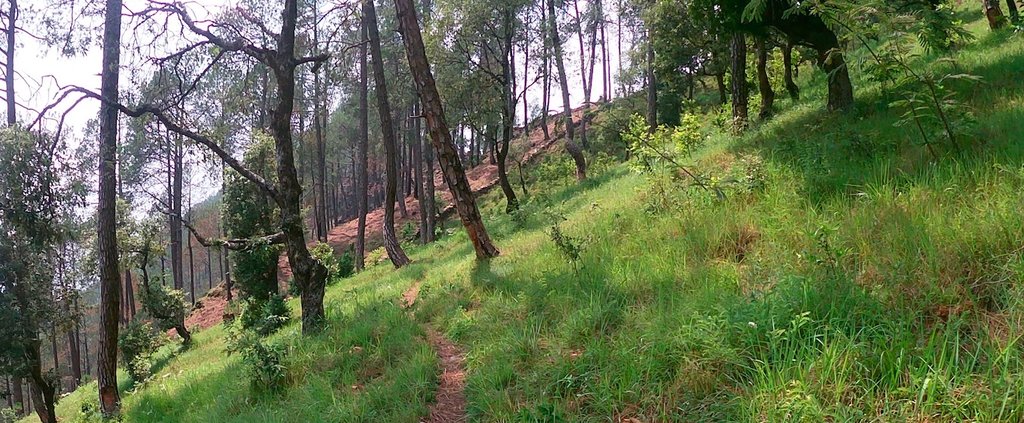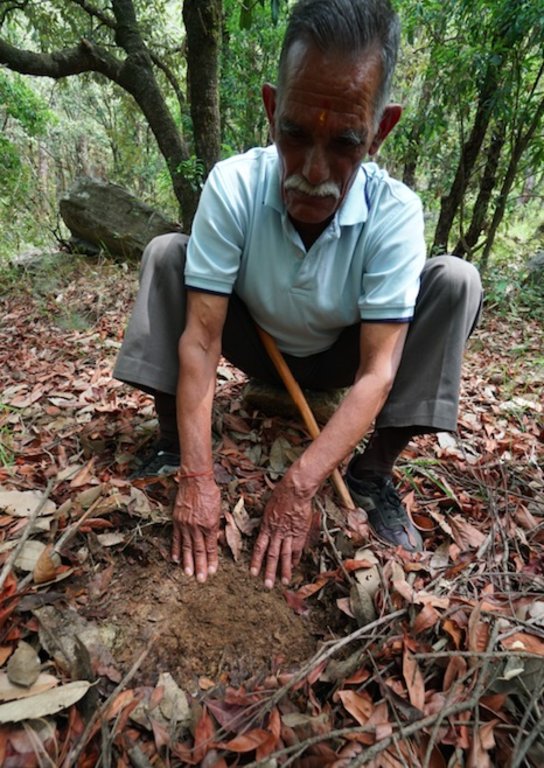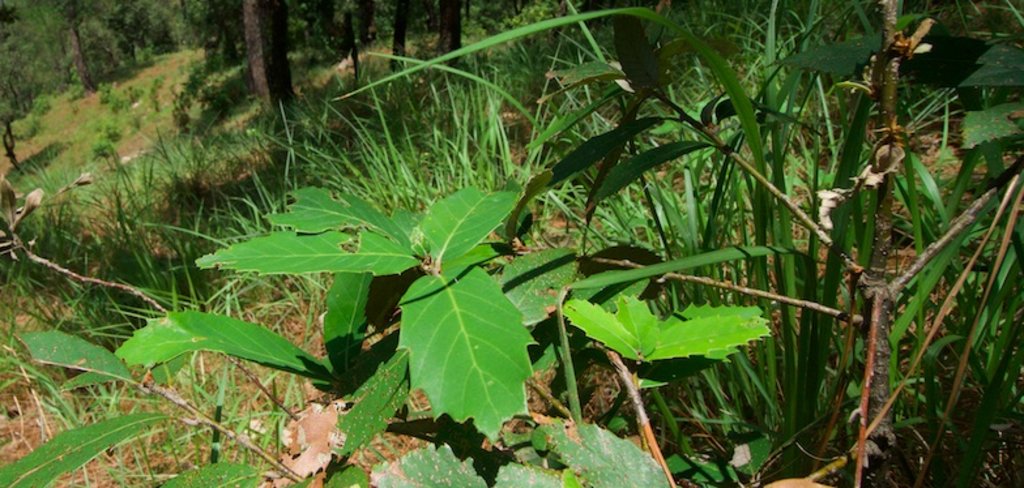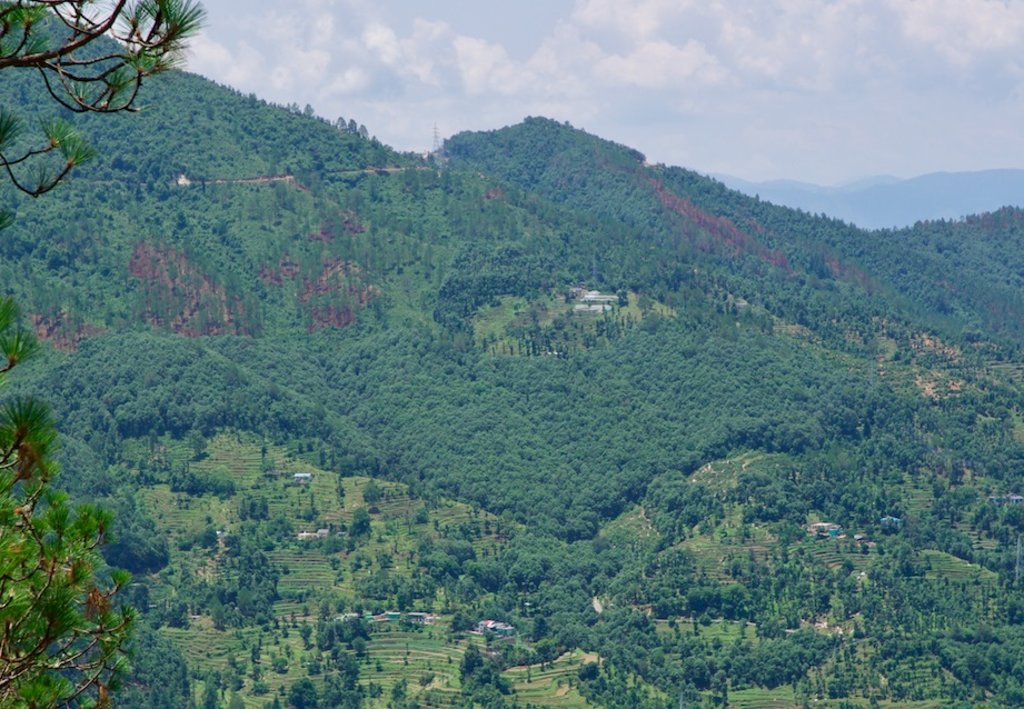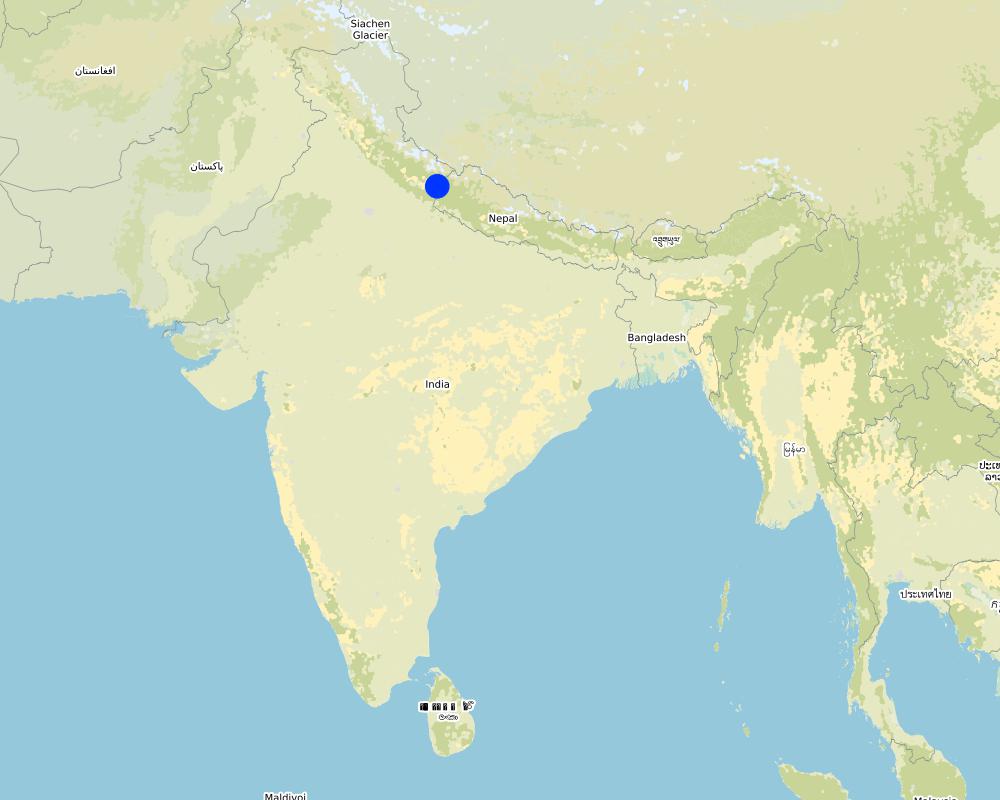Broadleaf Plantations, Assisted Tree Regeneration and Fodder Nurseries for Sustainable Forest Management [India]
- Creation:
- Update:
- Compiler: Jaclyn Bandy
- Editor: –
- Reviewer: Hanspeter Liniger
Trees: Banj Oak (Quercus leucotricophora/glauca), Phalat (Quercus lanata), Fodder: Napier grasses, Bhimal (Grewia optiva), Khadik (Celtis australis)
technologies_5243 - India
View sections
Expand all Collapse all1. General information
1.2 Contact details of resource persons and institutions involved in the assessment and documentation of the Technology
Key resource person(s)
land user:
Joshi Jagdamba Prashad
Sarpanch (Head) of Nakina Community Forest (Van Panchayat)
India
land user:
Pandey Basant Ballabh
Cucumber Farmer, Nakina Village
India
1.3 Conditions regarding the use of data documented through WOCAT
The compiler and key resource person(s) accept the conditions regarding the use of data documented through WOCAT:
Yes
1.4 Declaration on sustainability of the described Technology
Is the Technology described here problematic with regard to land degradation, so that it cannot be declared a sustainable land management technology?
No
Comments:
The land is suitable for afforestation and fodder nurseries. There are currently no signs of over exploitation with regards to natural resource use in the plantation area of the Nakina Forest.
1.5 Reference to Questionnaire(s) on SLM Approaches (documented using WOCAT)
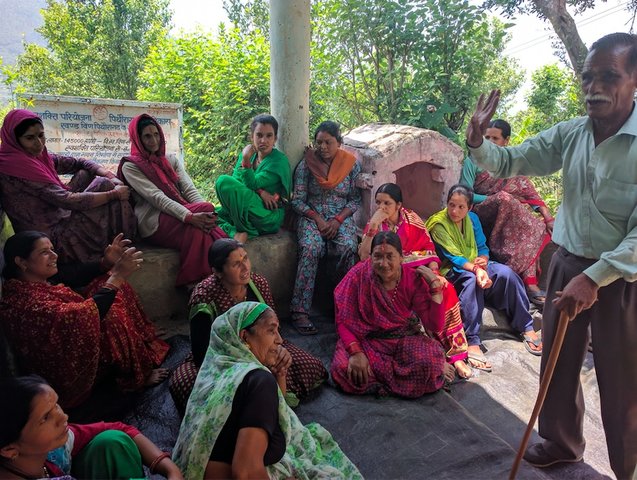
Community Forest Management in the Nakina Van Panchayat [India]
Van Panchayats or village forest councils are a impressive example of grassroots community management of natural resources, where a specific administrative unit is locally elected by community members who are responsible for the management of activities related to the forest.
- Compiler: Jaclyn Bandy
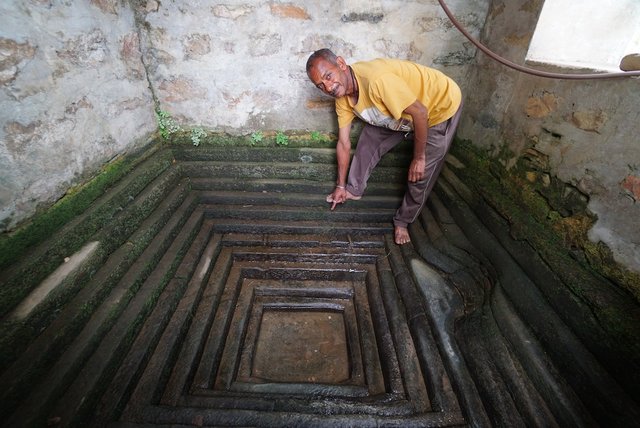
Naula Management and Conservation [India]
Naulas are shallow, four-sided stepped wells designed to collect water from subterranean seepages or springs and are used to meet domestic water needs by the local communities. Naula management and conservation encompasses a range of activities that preserve their structure and function.
- Compiler: Jaclyn Bandy
2. Description of the SLM Technology
2.1 Short description of the Technology
Definition of the Technology:
Natural assisted regeneration of broadleaved species, a small oak plantation and a fodder nursery have been established in the Nakina community forest (intervention area: 10 ha), supporting fodder tree species such as Banj Oak and Falyaat, as well as various subtropical temperate fodder grass species. This has improved the livelihood of the land-users by supporting the health and productivity of the forest, increasing the availability of fuel wood, fodder and groundwater for spring restoration.
2.2 Detailed description of the Technology
Description:
1. The technology is applied in a natural environment and is located about 1km away from the settlement and the agriculture land of Nakina Village. The village has access to its own forest, which covers a geographical area of 114 hectare. Of this, 94 hectares come under the Village Forest Council, locally referred to as the Van Panchayat.
2. Characteristics of Technology:
a. Broadleaf species have been established over 7 hectares through natural assisted tree regeneration methods. These include Banj Oak (Quercus leucotrichophora), Falyaat (Quercus glauca), Koeraal (Bauhinia verigata), Bhimal (Grewia optiva), Padam Paaya (Prunus cerasoides), Haradh (Terminalia chebula), Reetha (Sapindus Mukorossi), Utees (Alnus napalensis), Ainyar (Lyonia ovalifolia), Khadik (Celtis australis).
b. Nakina Van Panchayat has made an oak plantation site of 2 hectares in collaboration with G.B. Pant Research Institute.
c. A fodder nursery covering 1 hectare hosts a variety of subtropical (Napier: Pennisetum purpureum, Aus, Ginni) and temperate grasses (Guchhi, Dolni, Italian rye: Lolium multiflorum). It was established with the assistance of the NGOs Swati Gramodyog Sansthan and the Himalayan Sewa Samiti. Extraction of fodder leaves and timber are restricted and regulations managed by the Van Panchayat (community forest council).
Purposes/functions:
-Increase trees and grasses to improve availability of fuel and fodder for community, as well as enrich biodiversity.
-Plantation is on a mountain slope (+25% slope), so it will help in preventing soil erosion and landslides.
-Improve soil and water conservation, prevention of surface run-off, support groundwater recharge and spring rejuvenation.
Major activities/Inputs needed to establish and maintain technology:
1. Activities for Assisted Natural Regeneration: protect and facilitate the growth of parent trees inherently present in the area and their regenerations, rather than establishment of entire plantation
2.Activities for the oak plantation: Selection and seed provision of appropriate tree species, clearing of vegetation and preparation of forest top soil, leveling of soil, digging of plantation pits, sowing weeding, watering, occasional pruning, propagation of trees from cuttings, dead sapling replacement, establishment of barrier/fencing for protection from fire.
3. Activities for fodder nursery:- Selection and seed provision of appropriate grass species and polypot materials, preparation of seedbeds; clearing of vegetation, removal of stones/large roots, ploughing/hoeing, mixing sand and compost on areas with poor soil, sowing seeds pre-monsoon, weeding and watering seedlings, propagation from seed or root cuttings, dead sapling replacement, establishment of barrier/fencing protection from fire.
Benefits/Impacts:
•Restores productivity and fodder/fuelwood availability
•Ecosystem stability
•Enhancement of biological diversity to degraded lands.
•Control landslide and soil erosion
•Control forest fire.
•Maintain wildlife habitat
•Increase livelihood of local people, decrease time spent collecting fodder
•Storage carbon on the forest help to reduce the CO2 in the atmosphere.
Likes:
This technology is properly functioning in the implementation area and local people have received many benefits from sustainable managing their natural resources rather than receiving incentives for institutional support, local people of the Nakina village are strongly active to protect the forest with their own coordination.
Dislikes:
1.Improve wildlife habitat, which may increase human wildlife conflicts as it is near to agriculture land and settlements.
2.Require regular maintenance activities, which require organization within the community and can increase periodic workload depending on level of participation
2.3 Photos of the Technology
2.5 Country/ region/ locations where the Technology has been applied and which are covered by this assessment
Country:
India
Region/ State/ Province:
Uttarakhand
Further specification of location:
Nakina Village, Pithoragarh Bloc
Specify the spread of the Technology:
- applied at specific points/ concentrated on a small area
Is/are the technology site(s) located in a permanently protected area?
Yes
If yes, specify:
Nakina Van Panchayat (community forest)
Map
×2.6 Date of implementation
If precise year is not known, indicate approximate date:
- 10-50 years ago
2.7 Introduction of the Technology
Specify how the Technology was introduced:
- through land users' innovation
- through projects/ external interventions
Comments (type of project, etc.):
After the Nakina Van Panchyat was established in 1952 they already had experience working on plantations. During the British-era, timber extraction, pine plantations and prescribed fire exploded in the region. Much of the oak forests were reverted to pine, and many broadleaved species like were overexploited for construction, fuelwood, and fodder. Nakina's self-initiated plantation efforts were done in hopes to restore it to its original state.
Other supporting organizations and institutions have recognized the need for further support for the following reasons: demand for fuel and fodder is still insufficient during the dry season, water scarcity has become a prevalent issue, and biological interventions are necessary to improve and sustain ecosystem services. Due to the expressed interest and dedication of the community, these projects have been accomplished.
3. Classification of the SLM Technology
3.1 Main purpose(s) of the Technology
- improve production
- reduce, prevent, restore land degradation
- conserve ecosystem
- protect a watershed/ downstream areas – in combination with other Technologies
- preserve/ improve biodiversity
- reduce risk of disasters
- adapt to climate change/ extremes and its impacts
- create beneficial economic impact
3.2 Current land use type(s) where the Technology is applied
Land use mixed within the same land unit:
Yes

Grazing land
Intensive grazing/ fodder production:
- Cut-and-carry/ zero grazing
Animal type:
- cattle - dairy
- goats
Is integrated crop-livestock management practiced?
Yes
If yes, specify:
Compost was made from manure of livestock for plantation and fodder nursery preparation.
Products and services:
- meat
- milk

Forest/ woodlands
- (Semi-)natural forests/ woodlands
- Tree plantation, afforestation
(Semi-)natural forests/ woodlands: Specify management type:
- Selective felling
Type of (semi-)natural forest:
- subtropical dry forest natural vegetation
Tree plantation, afforestation: Specify origin and composition of species:
- Mixed varieties
Type of tree plantation, afforestation:
- subtropical dry forest plantation - Broadleaf
- Banj Oak (Quercus leucotricophora), Falyaat (Quercus glauca), Koeraal (Bauhinia verigata), Bhimal (Grewia optiva), Padam Paaya (Prunus cerasoides), Haradh (Terminalia chebula), Reetha (Sapindus Mukorossi), Utees (Alnus napalensis), Ainyar (Lyonia ovalifolia)
Are the trees specified above deciduous or evergreen?
- deciduous
Products and services:
- Timber
- Fuelwood
- Other forest products
- Grazing/ browsing
- Nature conservation/ protection
3.3 Has land use changed due to the implementation of the Technology?
Has land use changed due to the implementation of the Technology?
- No (Continue with question 3.4)
3.4 Water supply
Water supply for the land on which the Technology is applied:
- rainfed
3.5 SLM group to which the Technology belongs
- natural and semi-natural forest management
- forest plantation management
- improved ground/ vegetation cover
3.6 SLM measures comprising the Technology

vegetative measures
- V1: Tree and shrub cover
- V2: Grasses and perennial herbaceous plants
- V3: Clearing of vegetation
- V4: Replacement or removal of alien/ invasive species
- V5: Others

management measures
- M1: Change of land use type
- M2: Change of management/ intensity level
- M3: Layout according to natural and human environment
- M5: Control/ change of species composition
3.7 Main types of land degradation addressed by the Technology

soil erosion by water
- Wt: loss of topsoil/ surface erosion
- Wg: gully erosion/ gullying
- Wm: mass movements/ landslides
- Wo: offsite degradation effects

chemical soil deterioration
- Cn: fertility decline and reduced organic matter content (not caused by erosion)
- Ca: acidification

physical soil deterioration
- Pc: compaction
- Pk: slaking and crusting
- Pi: soil sealing
- Pu: loss of bio-productive function due to other activities

biological degradation
- Bc: reduction of vegetation cover
- Bh: loss of habitats
- Bq: quantity/ biomass decline
- Bf: detrimental effects of fires
- Bs: quality and species composition/ diversity decline
- Bl: loss of soil life
- Bp: increase of pests/ diseases, loss of predators

water degradation
- Ha: aridification
- Hs: change in quantity of surface water
- Hg: change in groundwater/aquifer level
- Hp: decline of surface water quality
- Hq: decline of groundwater quality
3.8 Prevention, reduction, or restoration of land degradation
Specify the goal of the Technology with regard to land degradation:
- reduce land degradation
- restore/ rehabilitate severely degraded land
4. Technical specifications, implementation activities, inputs, and costs
4.1 Technical drawing of the Technology
Technical specifications (related to technical drawing):
G.B. Pant Plantation: 2 Hectare, pits of (30 cm X 30cm X 45cm) were dug along contour lines, spacing of pits is not less than 2x2 m, about 2,000 Quercus saplings were planted.
Nakina Broadleaf Plantation: 7 Hectare, pits of (30 cm X 30cm X 45cm) were dug along contour lines, spacing of pits is no less that 2x2 m, about 15,000 trees have been planted and the forest is being continually managed in the area.
Species: Banj Oak (Quercus leucotrichophora), Falyaat (Quercus glauca), Koeraal (Bauhinia verigata), Bhimal (Grewia optiva), Padam Paaya (Prunus cerasoides), Haradh (Terminalia chebula), Reetha (Sapindus Mukorossi), Utees (Alnus napalensis), Ainyar (Lyonia ovalifolia), Khadik (Celtis australis)
Fuelwood cutting (lopping), fodder collection, and selective clear cutting for Quercus leucotrichophora and other broadleaved species is done between Nov- April.
Fodder Nursery: 20 Quintals (20,000 kg) of various grassroot slips over 1 Hectare. This provides +175 tonnes/year. (Subtropicals species: napier, aus, ginni, Temperate species: guchhi, dolni, italian rye)
Planting: Grasses are planted during the months of June-July at the advent of rainy season, about 10 cm deep vertically and at a spacing of 45 x 30 cm apart.
Propagation: grasses forms clumps during its growth period. The clump when broken gives a number of small units known as slips, which are the units of propagation and on planting, they establish as individual plants. While preparing the slips for planting, fibrous roots and leaves are be trimmed off. Cuttings with 2 nodes from the middle portion of moderately matured stems (3 – 4 months old) were planted in a slanting position at one side of the ridges with one node buried in the soil. The underground node develops roots and shoots while the upper node shoots only. The soil around the stem is pressed tightly. Farm yard manure is applied after harvest (application rate varies; estimation is 5-8 tonnes). Annually about 6 to 8 cuts are possible.
Oak Nursery: 0.25 ha. The nursery bed is rectangular and measures about 100m x 25 m. The seedlings are uprooted by hand from a seedbed and transplanted (bare-root transplanting). The nursery is on a gently sloping land (23%). Seedlings with poor lateral root development are culled out.
Oak Plantation Alternative:
Acorns are collected and put in water for 24 hours. Acorns that sink are immediately sown in a well tilled seedbed 2-5 cm deep, 15 cm from each other and covered with a thin layer of firm soil. Beds are mulched with straw or leaves. However, not every acorn will germinate and animal predation of acorns can be an issue. In general, probability of success is lower than with seedlings.
Author:
Jaclyn Bandy
Date:
25/07/2019
Technical specifications (related to technical drawing):
Google Map of Plantations and Fodder Nursery locations
Author:
Jaclyn Bandy
Date:
25/07/2019
Technical specifications (related to technical drawing):
Project Budget with Nakina Village and NGO Himalayan Sewa Samiti: Fodder Nursery, 1 hectare and Assisted Natural Regeneration 97 Hectares)
(Citation: Detailed Project Report: Natural Resource Based Livelihood Project in the Gorang Ghati Cluster, NGO Himalayan Sewa Samiti, Submitted to: Sir Ratan Tata Trust (SRTT) Forest Works Manual, 2015 Forest Research Institute, Dehradun, Uttarakhand)
Author:
J Bandy
Technical specifications (related to technical drawing):
Project Budget for Afforestation of Nakina Community Forest and G.B. Pant Institute of Himalayan Environment and Development: Broadleaf Plantation (2 hectares)
(Citation: Forest Works Manual, 2015 Forest Research Institute, Dehradun, Uttarakhand)
Author:
J Bandy
4.2 General information regarding the calculation of inputs and costs
Specify how costs and inputs were calculated:
- per Technology area
Indicate size and area unit:
Afforested Community Forest: 7 hectares, G.B. Pant Plantation: 2 hectares, Fodder Nursery: 1 hectare
other/ national currency (specify):
INR
If relevant, indicate exchange rate from USD to local currency (e.g. 1 USD = 79.9 Brazilian Real): 1 USD =:
70.0
Indicate average wage cost of hired labour per day:
400 INR
4.3 Establishment activities
| Activity | Timing (season) | |
|---|---|---|
| 1. | Plantations: Survey, demarcation, clearance of shrubs, bushes, Lantana (invasive species) | Pre-monsoon |
| 2. | Earth work for leveling, Digging pits (30 cm X 30cm X 45cm) along contour lines, spacing of pits no less that 2x2 m, filling of pits with soil/manure mixture | Early June |
| 3. | Planting of saplings: roots of the plants kept straight and the plant put straight in vertical position; done by digging with the help of a stick or small crow bar | Early July |
| 4. | Note: Species like Akhrot, Angu, Maple, Pangar, Poplar, Salix, Utis etc. are planted in winter months | January/February |
| 5. | Dead, dying or dry plants are replaced within 15 days of completion of planting work | Mid June |
| 6. | Thanwalas (semicircular pit) about 15 cm deep, 25-30 cm apart from the plant were dug for rainwater retention/infiltration | Mid June |
| 7. | Weeding after first significant rains | Monsoon |
| 8. | Fodder Nursery: Survey, demarcation, clearance of shrubs, bushes, Lantana (invasive species) | Pre-monsoon |
| 9. | Plowing/hoeing land, collection and soil, sand, manure preparation (4:2:1 ratio) and seedbed preparation | Pre-monsoon |
| 10. | Planting of each cane/rootsplit in holes 15-30 cm deep, with a spacing of 0.5m x 0.5m | Pre-monsoon |
| 11. | Cutting and Harvesting |
Comments:
Oak Plantation: Seeds are collected from dominant oak trees that exhibit superior phenotypic traits such as tall straight trunks, good diameter growth rates and well-developed crowns (branches/leaves)
Cuttings:
4.4 Costs and inputs needed for establishment
| Specify input | Unit | Quantity | Costs per Unit | Total costs per input | % of costs borne by land users | |
|---|---|---|---|---|---|---|
| Labour | Plantation Community Manual labour | person-days | 400.0 | 400.0 | 160000.0 | 50.0 |
| Labour | Skilled labour (advisor, experts) | person-days | 7.0 | 2000.0 | 14000.0 | |
| Labour | Fodder Nursery Raising | Total Cost | 1.0 | 25000.0 | 25000.0 | 25.0 |
| Equipment | Axe, Crow bar, Wheel barrow | pieces | 10.0 | 1500.0 | 15000.0 | 100.0 |
| Equipment | Digging forks, Hammers, Hoes, Spade | pieces | 10.0 | 1500.0 | 15000.0 | 100.0 |
| Equipment | Scissors, Pruning knives/shears, Budding and Grafting Knives/Tape | pieces | 10.0 | 700.0 | 7000.0 | 50.0 |
| Plant material | Fodder Grass/20 Quintals of Grassroot slips | Total Cost | 1.0 | 45000.0 | 45000.0 | 50.0 |
| Plant material | Plantation Material, 3.88 INR per Sapling x 1000 Sapling per hectare x 7 hectare | Total Cost | 1.0 | 27160.0 | 27160.0 | 50.0 |
| Fertilizers and biocides | Soil/Water Conservation and Soil Fertility Measures: 5,500 INR per Hectare x 2 | Total Cost | 1.0 | 11000.0 | 11000.0 | 100.0 |
| Fertilizers and biocides | Nakina Forest: Assisted Natural Regeneration preparation and composting | Total Cost | 1.0 | 2000.0 | 2000.0 | 100.0 |
| Fertilizers and biocides | Fodder Nursery composting | Total Cost | 1.0 | 1000.0 | 1000.0 | 100.0 |
| Other | Plantation Transportation, Pitting, Planting: 6.9 INR per plant X 1000 sapling x 2 hectare | Total Cost | 1.0 | 13800.0 | 13800.0 | 50.0 |
| Other | Fodder Nursery (Rootstock Purchase, Transportation) | Total Cost | 1.0 | 5500.0 | 5500.0 | 50.0 |
| Other | Nakina Village: Assisted Natural Regeneration Activities in Planted Plots, 10,000 INR per hectare X 7 hectares x 3 years | Total Cost | 1.0 | 30000.0 | 30000.0 | 100.0 |
| Total costs for establishment of the Technology | 371460.0 | |||||
| Total costs for establishment of the Technology in USD | 5306.57 | |||||
If land user bore less than 100% of costs, indicate who covered the remaining costs:
UTFD (Forest Department): funds mobilized by the MNEGRA (Mahatma Gandhi National Rural Employment Guarantee Act), JICA, G.B. Pant, NGO Himalayan Sewa Samiti (Sir Ratan Tata Trust's Contribution)
Comments:
For G.B. Pant Plantation and Nakina Forest Plantation:
On average we estimated a maximum of 10 people worked on establishing the technology/day = 400 x 10 = 4000 (labor cost/day): 4,000 X 40 days = 160,000 INR Total Cost
Some of the community laborers were compensated for the initial phase of establishing the plantation with G.B. Pant Plantation, but for the Nakina Plantation most of the work was voluntary by the community over many years. Nakina Van Panchayat has a joint bank account (Almora Urban Cooperative Bank) with officials from the Forest Department. Money from the Forest Department/ JICA (Japanese International Cooperation Agency) gets deposited there. A portion of this is used to compensate the village workers (~400 INR/day) .
NGO Himalayan Sewa Samiti (HSS) was involved in supporting the fodder nursery and some plantation support.
For the original project budget outline for the Fodder Nursery, please see the attached document in the Technical Drawing section from the NGO HSS.
For further details on the plantation budget, please see the tables in the Technical Drawing section from the Forest Works Manual/Schedule of rates for forest work in Uttarakhand.
4.5 Maintenance/ recurrent activities
| Activity | Timing/ frequency | |
|---|---|---|
| 1. | Second weeding done in September, followed by a third weeding after the winter rains. | Post-monsoon |
| 2. | A Chowkidar (forest watch guard) is deputed for five years in the plantation area to look after it | Post-planting |
| 3. | Periodical weeding and removal of grasses suppressing the plants, maintenance and repair of inspection paths | Year round |
| 4. | Fire Control: Keeping regular watch over the plantation area during the fire season, cleaning of the outer periphery of the plantation area in two meter width | Dry season |
| 5. | Collective help and co-operation with the villagers in the protection of the plantation; checks on fodder extraction/allowance, prevention of trespassers (human/wildlife) | Year round |
| 6. | During the second year, dead plants are replaced by planting fresh saplings (ca. 20%) | Onset of monsoon |
| 7. | Fodder grasses: propagation from cuttings or from root slips | |
| 8. | Fodder Grasses: Harvesting of grasses every 6-8 weeks, maintaining a stubble height of 5-10 cm from the ground level at each harvest to avoids weakening of root system |
4.6 Costs and inputs needed for maintenance/ recurrent activities (per year)
| Specify input | Unit | Quantity | Costs per Unit | Total costs per input | % of costs borne by land users | |
|---|---|---|---|---|---|---|
| Labour | Maintenance of nursery | Total Cost/Year | 1.0 | 3000.0 | 3000.0 | 25.0 |
| Labour | Maintenance of plantations | Total Cost/Year | 1.0 | 4000.0 | 4000.0 | 25.0 |
| Total costs for maintenance of the Technology | 7000.0 | |||||
| Total costs for maintenance of the Technology in USD | 100.0 | |||||
If land user bore less than 100% of costs, indicate who covered the remaining costs:
UTFD (Forest Department): funds mobilized by the MNEGRA (Mahatma Gandhi National Rural Employment Guarantee Act), JICA, NGO Himalayan Sewa Samiti (Sir Ratan Tata Trust's Contribution)
Comments:
Please see estimated maintenance costs attached in references.
In general, the land users bear the labor costs of maintenance, but they received inputs and other support to maintain the fodder nursery and plantations for a few years (2-3) after the projects were executed. Otherwise, remaining funds in the joint bank account with Nakina Van Panchayat and UTFD/JICA are accessed for necessary supplies and labor compensation.
4.7 Most important factors affecting the costs
Describe the most determinate factors affecting the costs:
-Length and amount of available funding, as plantation projects require substantial investment and long term care.
-Damage or survival rate of the saplings/trees/fodder species can be severely affected by climatic, anthropogenic, or wildlife disturbances. The success and cost of a plantation and nursery project can vary widely depending on size, topographic characteristics, access, labor availability and overall appropriateness of site selection.
5. Natural and human environment
5.1 Climate
Annual rainfall
- < 250 mm
- 251-500 mm
- 501-750 mm
- 751-1,000 mm
- 1,001-1,500 mm
- 1,501-2,000 mm
- 2,001-3,000 mm
- 3,001-4,000 mm
- > 4,000 mm
Specify average annual rainfall (if known), in mm:
1500.00
Specifications/ comments on rainfall:
Monsoon- mid-June to mid-September; July and August are the rainiest months and the temperature is warm and moist; between 70-85% of the annual precipitation occurs in the monsoon season
Seasons
a. Winter or Cold weather (mid Dec. - mid March)
b. Summer or hot weather (mid March - mid June)
c. Season of general rains (South - West monsoon season)
d. Season of retreating monsoon (mid September to mid November)
Indicate the name of the reference meteorological station considered:
India Meteorological Department, Meteorological Centre Dehradun
Agro-climatic zone
- sub-humid
The overall climatic condition in the Pithoragarh district is governed by the southwest monsoon. It has a sub-tropical to temperate climate, with three pronounced seasons; summer, winter, and monsoon. The hilly terrain of the Himalayan region has snow cover and is cold during winter with snowfall normally occurring during the months of December to March.
Temperature- The temperature ranges from 0°C to 10°C in winter and from 8°C to 33°C in summer season. However, there is no meteorological observatory in the district. The account of the climate is based mainly on the records of the observations in the neighboring districts where similar meteorological conditions prevail. Variations in temperature are considerable from place to place and depend upon elevation as well as aspect. As the insolation is intense at high altitudes, in summer temperatures are considerably higher in the open than in the shade.
5.2 Topography
Slopes on average:
- flat (0-2%)
- gentle (3-5%)
- moderate (6-10%)
- rolling (11-15%)
- hilly (16-30%)
- steep (31-60%)
- very steep (>60%)
Landforms:
- plateau/plains
- ridges
- mountain slopes
- hill slopes
- footslopes
- valley floors
Altitudinal zone:
- 0-100 m a.s.l.
- 101-500 m a.s.l.
- 501-1,000 m a.s.l.
- 1,001-1,500 m a.s.l.
- 1,501-2,000 m a.s.l.
- 2,001-2,500 m a.s.l.
- 2,501-3,000 m a.s.l.
- 3,001-4,000 m a.s.l.
- > 4,000 m a.s.l.
Indicate if the Technology is specifically applied in:
- concave situations
Comments and further specifications on topography:
Altitude of evaluated sites: 1850-1990m
Slope: 23-30%
5.3 Soils
Soil depth on average:
- very shallow (0-20 cm)
- shallow (21-50 cm)
- moderately deep (51-80 cm)
- deep (81-120 cm)
- very deep (> 120 cm)
Soil texture (topsoil):
- coarse/ light (sandy)
- medium (loamy, silty)
Soil texture (> 20 cm below surface):
- medium (loamy, silty)
Topsoil organic matter:
- medium (1-3%)
- low (<1%)
If available, attach full soil description or specify the available information, e.g. soil type, soil PH/ acidity, Cation Exchange Capacity, nitrogen, salinity etc.
Mountain/hill soils are a collective name given to various types of soils found under the following conditions :
-under sub-tropical, temperate and sub-alpine conditions
-under various forest types
Characteristics: very thin, fertile, and may be less than a centimeter deep on steep slopes; they are mixed with pebbles, shingles (a mass of small rounded pebbles), and gravels; they have a low-medium water holding capacity. Angular and subangular fragments of parent rock may be found mixed with the lower layers of the mountain and hill soils.
Texture: varies from loamy to sandy loam.
Soil Reaction: ranges from acidic to neutral (pH 4.6 to 6.5)
Organic Matter content: 1-5%
Ferrugenous red roils are found in this district and are well developed over Himalayan rocks (quartzite, biotite schist, amphibolite schist). They are free of carbonates and deficient in nitrogen, humus and phosphorus, light textured, porous, and friable (brittle/crumbly). The soil depth ranges from about 10cm-75 cm. These soils may be grouped into two on basis of morphology
1. Red earths- loose, friable topsoil rich in secondary concretions (hard, compact mass of matter formed by the precipitation of mineral cement within the spaces between particles, and is found in sedimentary rock or soil)
2. Red loam- argillaceous soils having a blocky structure (argillaceous minerals may appear silvery upon optical reflection and are minerals containing substantial amounts of clay-like components, e.g. argillaceous limestones are limestones consisting predominantly of calcium carbonate, but including 10-40% of clay minerals)
Brown soil: is found particularly under dense broadleaved temperate and sub-alpine forests. There occurs a thick layer of humus on the forest floor (made of decomposed leaves, branches, twigs) and the topsoil is extremely rich in humus
Podsolic Soil: soil that has developed in humid/temperate conditions usually under coniferous forests (e.g. deodar, blue pine, fir, spruce) over quartzite, granites, schists and gneiss.
(Citation: Kumaun: The Land and the People, Sharad Singh Negi (1993)
5.4 Water availability and quality
Ground water table:
5-50 m
Availability of surface water:
medium
Water quality (untreated):
good drinking water
Water quality refers to:
ground water
Is water salinity a problem?
No
Is flooding of the area occurring?
No
Comments and further specifications on water quality and quantity:
Quantity: Water crisis has been a perennial problem in both the rural and urban areas of the Pithoragarh district
There is scarcity of safe drinking water of the villages in the study area. Hand pumps are often not functioning, pipe-water schemes are unreliable and the spring discharges have reduced during the dry season. Hand-pumped water often has a high iron content and bitter taste. Poor quality of groundwater in some of the naulas is mainly due to misuse and/or disuse of the structures.
A block-district groundwater resource estimation could not be carried out as the area is hilly (with slope >20%) and in major part aquifers are small, isolated bodies, and groundwater abstraction is done mainly through hand pumps and springs with small discharges.
However, we collected some physicochemical parameters that indicate the water (sourced from springs) is of good quality:
Water Quality Parameters of Springs:
pH: 6.29-8.18
Temp: 19.0-23.5 ºC
Electrical Conductivity: 109-504 µmsiemens
Total Dissolved Solids: 75-385 ppm
5.5 Biodiversity
Species diversity:
- medium
Habitat diversity:
- medium
Comments and further specifications on biodiversity:
Uttarakhand has more than 7000 species of medicinal plants and 500 species of fauna. Floral diversity contributes 31% of total floral density of India. Fauna contributes just 1.58% of the total faunal density of the country. There are 119 endemic species of flowering plants in the state that exhibited 2.35% endemism and 35 faunal endemic species. Because it lies at the juncture of India, Nepal and the Tibeten Autononmous region, there often cases of poaching and smuggling of wildlife contrabands, including bear bile, musk pods and leopard skins through the borders. Yarsa Gumba Ophiocordyceps sinensis, commonly known as Caterpillar Fungus, is also illegally traded transboundary in the region, together with various plant species. Due to anthropogenic impacts, changes is soil quality, and climatic elements, the biodiversity of our study site is not as high as in other areas of the Pithoragarh district.
Citation: Sundriyal, M. & Sharma, B. (2016). Status of Biodiversity in Central Himalaya, Applied Ecology and Environmental Sciences, 4( 2), 37-43.
5.6 Characteristics of land users applying the Technology
Sedentary or nomadic:
- Sedentary
Market orientation of production system:
- subsistence (self-supply)
- mixed (subsistence/ commercial)
Off-farm income:
- 10-50% of all income
- > 50% of all income
Relative level of wealth:
- poor
Individuals or groups:
- groups/ community
Level of mechanization:
- manual work
Gender:
- women
- men
Age of land users:
- youth
- middle-aged
- elderly
Indicate other relevant characteristics of the land users:
With recent development in Pithoragarh, an influx of funds coming from outside sources has caused a decline in the importance of agriculture production, which in now marginalized, based on female labour, and mainly conducted for subsistence with little surplus to sell. High caste men do not work in cultivation at all, and male tasks such as ploughing are performed by the Scheduled Caste.
Although most women are still cultivating, their work has lost economic importance. For most families, the produce does not cover the needs of the household and surplus must be bought from the market. Many of the terraces that were formerly fruit orchards (mainly citrus) have been completely abandoned. Farming is less intensive and landholdings are small and fragmented. The main crops are wheat, millet, and pulses, but yields are low as the land is not irrigated. Less livestock (cows, goats, buffalo) is kept because of the labor involved. Very little capital is returned to farming. Crops produced for the markets in the plains are replacing traditional crops to sustain the household.
With exposure to the“Modern” lifestyle, new values have also been accepted. Two children are the norm (the ideal being one son and one daughter, but at least one son in a must). Although access to education is quite good, it does not seem to result in working careers for women.
5.7 Average area of land used by land users applying the Technology
- < 0.5 ha
- 0.5-1 ha
- 1-2 ha
- 2-5 ha
- 5-15 ha
- 15-50 ha
- 50-100 ha
- 100-500 ha
- 500-1,000 ha
- 1,000-10,000 ha
- > 10,000 ha
Is this considered small-, medium- or large-scale (referring to local context)?
- small-scale
5.8 Land ownership, land use rights, and water use rights
Land ownership:
- communal/ village
Land use rights:
- communal (organized)
Water use rights:
- open access (unorganized)
- communal (organized)
Are land use rights based on a traditional legal system?
Yes
Specify:
Under the Kumaun Panchayat forest rules of 1931 (amended in 1976): A Van Panchayat, (community forest council), can be formed out of non-private land within the settlement boundaries of a village. Accordingly, all villagers are members of the VP upon their approval by a Sub-Divisional Magistrate under the state Revenue Department. The members are collectively referred to as the general body, which selects the management committee members through a democratic process.
Comments:
5-9 elected members assume control of the forest and the extent of villager use. They additionally raise funds and mobilize the village to protect and support sustainable land use. Presently 12,089 Van Panchayats are entrusted with the management of over 5,449.64 km2 of forests.
5.9 Access to services and infrastructure
health:
- poor
- moderate
- good
education:
- poor
- moderate
- good
technical assistance:
- poor
- moderate
- good
employment (e.g. off-farm):
- poor
- moderate
- good
markets:
- poor
- moderate
- good
energy:
- poor
- moderate
- good
roads and transport:
- poor
- moderate
- good
drinking water and sanitation:
- poor
- moderate
- good
financial services:
- poor
- moderate
- good
Comments:
The situation of infrastructure is difficult and inconsistent in the hill regions because of the terrain. The major infrastructural issues are drinking water and irrigation facilities, electricity, transportation and communication facilities and social infrastructure (housing and education). As for financial services, only the State Bank of India (SBI) is active in the hill regions where it is trying to achieve the objective of 100% financial inclusion. Some villages mentioned buying into into agricultural insurance in the past, however this was a temporary enterprise and they were never compensated after extreme climatic events that occurred and damaged over 70% of their crop.
Though infrastructure and education has generally improved over the years, institutional and marketing networks in the region aimed at supporting hill-farmers are lacking.
6. Impacts and concluding statements
6.1 On-site impacts the Technology has shown
Socio-economic impacts
Production
fodder production
Quantity before SLM:
2 ton/ha
Quantity after SLM:
30 ton/hectare
fodder quality
animal production
wood production
forest/ woodland quality
Comments/ specify:
Tree lopping for fodder was decreased by 15%
production area
land management
Income and costs
expenses on agricultural inputs
Comments/ specify:
Decreased the amount of supplementary fodder required for livestock. The amount of grasses, fodder, and fuelwood has increased significantly.
workload
Comments/ specify:
Less time spent collecting forest resources, as the area where the technology is near the village and supports fodder/fuelwood growth (broadleaf forest/oak nursery area)
Socio-cultural impacts
food security/ self-sufficiency
Comments/ specify:
Improved self sufficiency of village, as the technology has helped increase animal productivity (more fodder, better quality) and increased water availability.
health situation
Comments/ specify:
Water condition has improved and people spend less time spent collecting fodder in the forest.
land use/ water rights
Comments/ specify:
There is less friction between the villages of Bhurimuni and Nakina. Nakina did not have to go ask for permission to access the Bhurimuni Naula for water during the dry season.
cultural opportunities
Comments/ specify:
The improvements of forest resource security and resilience to disasters/climatic extremes have allowed the villagers have more free time to build up a communal gathering area for ceremonial events and festivals around the Vaishnavi Temple.
recreational opportunities
Comments/ specify:
Recreation opportunities for villagers have increased. Particularly women, (some of whom are involved in a self help group and active Van Panchayat members), expressed that they saved approximately 1-2 hours/day in fodder collection time.
community institutions
Comments/ specify:
The partnerships formed between land-users, the Nakina Van Panchayat, the Forest Department and external institutions are leading examples of necessary cooperation between all levels of governance for project harmonization.
SLM/ land degradation knowledge
Comments/ specify:
People are taking forest management seriously and making innovative plans for further SLM interventions, whether it be community-initiated or with the help of external institutions/agencies.
conflict mitigation
Comments/ specify:
Conflict has decreased in the village do to increased availability of resources. The overall morale of the village is better and less frantic due to an improvement in dodder, fuel and water provision. This has further enhanced cooperation for interventions that require participation and effort in the community forest.
Ecological impacts
Water cycle/ runoff
water quantity
Comments/ specify:
The technologies improve water holding capacity of the soil by decreasing runoff velocity and improve overall water storage.
harvesting/ collection of water
surface runoff
groundwater table/ aquifer
evaporation
Soil
soil moisture
Comments/ specify:
Soil moisture of common land was increased by about 15%
soil cover
soil loss
Comments/ specify:
Trees and other vegetation has helped mitigate displacement of soil from upstream areas to the lowlands
soil accumulation
soil crusting/ sealing
soil compaction
nutrient cycling/ recharge
soil organic matter/ below ground C
acidity
Biodiversity: vegetation, animals
Vegetation cover
Comments/ specify:
Vegetation growth and cover has improved due to more shade and water availability
biomass/ above ground C
plant diversity
Comments/ specify:
Increased species diversity due to improved moisture availability, soil conditions and microclimate.
invasive alien species
animal diversity
Comments/ specify:
Provide more water and habitat for small animals/birds.
beneficial species
Comments/ specify:
Healthy afforested areas provide more water, habitat, and protection for microorganisms and insect species. They support native grasses and vegetation.
habitat diversity
Climate and disaster risk reduction
landslides/ debris flows
Comments/ specify:
Incidents of landslides decreased due to less surface flow velocity and soil destabilisation. Villagers also noted that there were that less displaced soil and sediment accumulation in the ravine that normally incurs damage from upstream debris flow in the monsoon season.
drought impacts
Comments/ specify:
Drought impacts decreased due improved surface and subsurface hydrological functioning in the upper watershed catchment areas. This increased microwatershed/ springshed groundwater stores and enhanced stream and spring flows in the dry season.
impacts of cyclones, rain storms
Comments/ specify:
Erosion impacts from extreme rain storms is reduced by decreasing flow velocity
emission of carbon and greenhouse gases
Comments/ specify:
Carbon storage is increased by the plantation. It has been previously studied that Uttarakhand Van Panchayat forests sequester carbon at the average rate of 3.5 t ha -1 yr-1. This varies depending on forest distribution, species and land management.
.
fire risk
Comments/ specify:
The forest intervention area is protected by the villagers from anthropogenic and wild fires, therefore the forest has rehabilitated more quickly and has a lower risk of burning due to improved green vegetation cover and less flammable pine needle accumulation. In the case of pine forests, pine needles are a major source of fuel for fire and the removal of buildup remains a major challenge for the land users.
micro-climate
Comments/ specify:
Because of the interventions, vegetation/biomass, soil cover and water availability has improved and created a more suitable microclimate for microorganisms, plants, animals and people. The microclimate has improved due to decreased surface temperatures from exposed, bare soil or ground that is covered with pine needles. This improved microclimate is visible, as it has additionally allowed a wider range of species (grasses, shrubs, wildflowers, insects, birds) to inhabit the intervention site.
6.2 Off-site impacts the Technology has shown
water availability
Comments/ specify:
Improved spring discharge in the peak dry season
reliable and stable stream flows in dry season
Comments/ specify:
Bhind and Vaishnavi Naulas (springs) have improved discharge in the peak dry season. According to villagers, there was little to no water available in May/June, and since 10 years the flow has returned due to the plantation efforts combination with structural technologies.
downstream flooding
Comments/ specify:
impact of flash flood is minimized
downstream siltation
Comments/ specify:
Helped slow down sediment and runoff
buffering/ filtering capacity
Comments/ specify:
No direct evidence, but statements from the locals indicate that there are less sediments in the spring water ( due to improved soil infiltration and buffering capacity)
damage on neighbours' fields
Comments/ specify:
Less damage from runoff
damage on public/ private infrastructure
Comments/ specify:
Decreased intensity of runoff on the roadside and settlement below
6.3 Exposure and sensitivity of the Technology to gradual climate change and climate-related extremes/ disasters (as perceived by land users)
Gradual climate change
Gradual climate change
| Season | increase or decrease | How does the Technology cope with it? | |
|---|---|---|---|
| annual temperature | increase | moderately | |
| seasonal rainfall | dry season | decrease | well |
| other gradual climate change | Irregular rainfall patterns/ delayed monsoon | increase | moderately |
Climate-related extremes (disasters)
Meteorological disasters
| How does the Technology cope with it? | |
|---|---|
| local rainstorm | well |
| local thunderstorm | well |
| local hailstorm | moderately |
Climatological disasters
| How does the Technology cope with it? | |
|---|---|
| drought | moderately |
| forest fire | well |
Hydrological disasters
| How does the Technology cope with it? | |
|---|---|
| landslide | moderately |
6.4 Cost-benefit analysis
How do the benefits compare with the establishment costs (from land users’ perspective)?
Short-term returns:
positive
Long-term returns:
very positive
How do the benefits compare with the maintenance/ recurrent costs (from land users' perspective)?
Short-term returns:
slightly positive
Long-term returns:
very positive
6.5 Adoption of the Technology
- 11-50%
Of all those who have adopted the Technology, how many did so spontaneously, i.e. without receiving any material incentives/ payments?
- 0-10%
Comments:
Establishing plantations is often a substantial investment and external monetary and technical support is required by the land-users.
6.6 Adaptation
Has the Technology been modified recently to adapt to changing conditions?
No
6.7 Strengths/ advantages/ opportunities of the Technology
| Strengths/ advantages/ opportunities in the land user’s view |
|---|
| Improves livelihood of villagers by addressing and significantly improving the fodder, fuel, water nexus. Increased fodder availability and decreased time spent collecting fodder/fuel in the forest has greatly benefited the village, and women in particular. Animal health and productivity has also increased. |
| Reduces erosion, improves catchment of runoff, increases groundwater availability and aids in spring recharge. |
| Supports soil quality and existing broadleaf forest; increased filtration, improved soil moisture and water availability. |
| Reduces impact of landslides and further downstream damage to settlements (water erosion, siltation) |
| Strengths/ advantages/ opportunities in the compiler’s or other key resource person’s view |
|---|
| Aligned with landuser |
| Improved microclimate, overall ecosystem health, and increased carbon sequestration. |
6.8 Weaknesses/ disadvantages/ risks of the Technology and ways of overcoming them
| Weaknesses/ disadvantages/ risks in the land user’s view | How can they be overcome? |
|---|---|
| Risk of damage to plantation and nursery from fires | Maintain protective barrier (wall and fire lane); more prominent live-fencing could be established around the fodder nursery, as it is under greater susceptibility to fire damage due to its location near the stone wall border and pine-dominant forest. |
| Moisture stress from weed competition reduces the growth of broadleaves | Consistent monitoring of weed and invasive species control (lantana) and eupatorium (Ageratina adenophora). |
| Weaknesses/ disadvantages/ risks in the compiler’s or other key resource person’s view | How can they be overcome? |
|---|---|
| There can be poor survival and slow growth of newly planted trees from damage while handling; e.g. the oak nursery has the potential to support many more plants, but it seems there is a need for more care when handling young broadleaved species. | Careful attention to plant handling, avoiding root damage, and appropriate timing of transplanting (e.g. avoid heat exposure) |
| Young oaks appeared somewhat nutrient deficient and are exposed in the forest; there were signs of animal intrusion or possibly damage by human crossing as the oak nursery is next to a small dirt trail. |
The survivability of the young oaks could be improved through mulching and establishing an enclosure or live fencing around the nursery. In the future, contour trenching and ponding can be also done before the plantations to improve the soil moisture. |
7. References and links
7.1 Methods/ sources of information
- field visits, field surveys
4: various villagers, Van panchayat community meeting
- interviews with land users
2: Mr. Joshi and woman who is an active member in the Van Panchayat
- interviews with SLM specialists/ experts
3, NGO Himalayan Sewa Samiti,
2 G.B. Pant, Dr. Ranbeer Rawal, Dr. Subodh Airy
When were the data compiled (in the field)?
25/07/2019
7.2 References to available publications
Title, author, year, ISBN:
Plant Nursery Management: Principles and Practices, P. Ratha Krishnan Rajwant K. Kalia J.C. Tewari M.M. Roy, 2014, ISO 9001 : 2008
Available from where? Costs?
http://www.cazri.res.in/publications/PRathaKrishnan.pdf
Title, author, year, ISBN:
Forest Works Manual and schedule of rates for Forestry Related Works, Uttarakhand, 2005, Forestry Research Institute, Dehradun
Available from where? Costs?
https://nrega.nic.in/1ForestWorksManual-FRI.pdf
7.3 Links to relevant online information
Title/ description:
Nursery Manual for Native Plants: A guide for tribal nurseries
URL:
https://www.fs.fed.us/rm/pubs_series/wo/wo_ah730.pdf
Title/ description:
Fodder and Forage Production
URL:
http://www.fao.org/3/T0706E/T0706E07.htm
Title/ description:
Nursery Technology
URL:
http://agritech.tnau.ac.in/forestry/nursery_major_activities.html
Title/ description:
Policy Brief: Spring Revival through Sustainable Land Management (SLM) in the Himalayan Foothills: Uttarakhand, North India. Author: Liniger HP, Bandy J, Year: 2020
URL:
https://www.wocat.net/en/projects-and-countries/projects/onsite-and-offsite-benefits-sustainable-land-management/india
Title/ description:
Video: SLM for Himalayan Spring Revival. Author: Liniger HP, Bandy J, Year: 2020
URL:
https://vimeo.com/429988881
Links and modules
Expand all Collapse allLinks

Community Forest Management in the Nakina Van Panchayat [India]
Van Panchayats or village forest councils are a impressive example of grassroots community management of natural resources, where a specific administrative unit is locally elected by community members who are responsible for the management of activities related to the forest.
- Compiler: Jaclyn Bandy

Naula Management and Conservation [India]
Naulas are shallow, four-sided stepped wells designed to collect water from subterranean seepages or springs and are used to meet domestic water needs by the local communities. Naula management and conservation encompasses a range of activities that preserve their structure and function.
- Compiler: Jaclyn Bandy
Modules
No modules


